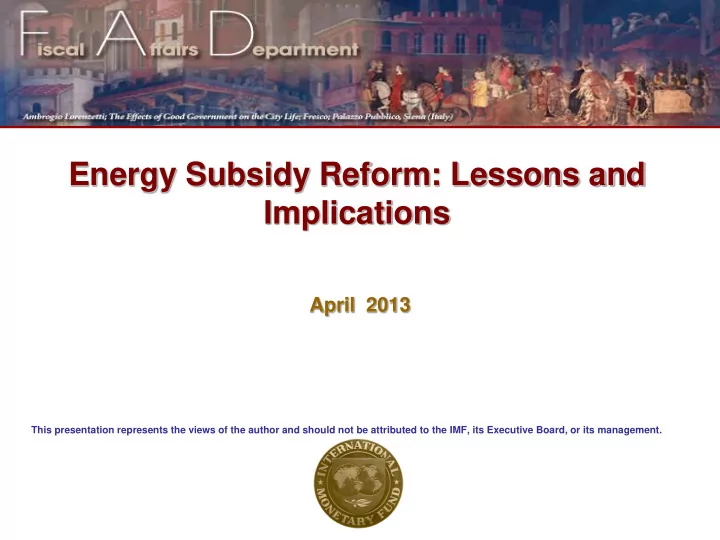

Energy Subsidy Reform: Lessons and Implications April 2013 This presentation represents the views of the author and should not be attributed to the IMF, its Executive Board, or its management.
Motivation and focus Energy subsidies have proven difficult to reform Paper provides comprehensive subsidy estimates covers 176 countries covers subsidies for petroleum products, electricity, natural gas, and coal Paper focuses on “how to do” subsidy reform case studies undertaken for 19 countries Joint paper by the IMF’s Fiscal Affairs, African, and Middle East and Central Asia Departments 2
Plan of presentation I. Consequences of energy subsidies II. Magnitude of subsidies by region and product III. “How to do” subsidy reform 3
I. Consequences of energy subsidies 4
Consequences of energy subsidies go well beyond fiscal costs Depress growth reduce investment in the energy sector crowd-out critical public spending over-allocate resources to energy intensive sectors Exert pressure on balance of payments of energy importers Create negative externalities (for example, global warming) Reinforce inequality 5
II. Magnitude of subsidies by region and product 6
Measuring consumer subsidies Pre-tax subsidies exist when energy consumers pay a price below the supply cost of energy, including transportation and distribution costs Tax subsidies arise if energy taxes are too low: energy should be taxed the same way as any other consumer product, plus additional taxes to account for the adverse effects of energy consumption Post-tax subsidies equal pre-tax + tax subsidies 7
Data sources Pre-tax subsidies IEA World Energy Outlook 2012 for 39 countries for electricity, natural gas, and coal OECD: producer subsidies for coal for 16 countries World Bank and IMF staff estimates for 36 countries in electricity IMF staff estimates for petroleum products (gasoline, diesel, kerosene) for 176 countries Pre-tax subsidies IMF staff estimates based on pre-tax subsidies and adjustments for revenue considerations and externalities 8
Petroleum and electricity dominate pre-tax subsidies, while coal subsidies are negligible Pre-tax $480 billion (0.7% GDP, 2.1% revenues) Coal Electricity Petroleum products Natural gas 9 Sources: IEA World Energy Outlook 2012 ; OECD; World Bank; and IMF staff estimates.
Post-tax subsidies are four times larger than pre- tax subsidies, with more than a quarter from coal Pre-tax Post-tax $480 billion (0.7% GDP, 2.1% revenues) $1.90 trillion (2.7% GDP, 8.1% revenues) Coal Coal Petroleum products Electricity Petroleum products Electricity Natural Natural gas gas 10 Sources: IEA World Energy Outlook 2012 ; OECD; World Bank; and IMF staff estimates.
Nearly half of pre-tax subsidies are from MENA region Pre-tax $480 billion (0.7% GDP, 2.1% revenues) S.S. Africa Advanced CEE-CIS E.D. Asia MENA LAC 11 Sources: IEA World Energy Outlook 2012 ; OECD; World Bank; and IMF staff estimates.
Advanced economies account for 40 percent of post-tax subsidies Post-tax Pre-tax $480 billion (0.7% GDP, 2.1% revenues) $1.90 trillion (2.7% GDP, 8.1% revenues) S.S. Africa Advanced S.S. Africa CEE-CIS MENA Advanced LAC E.D. Asia MENA E.D. Asia CEE-CIS LAC 12 Sources: IEA World Energy Outlook 2012 ; OECD; World Bank; and IMF staff estimates.
As a share of GDP, post-tax subsidies are high in MENA and low in advanced economies 15 10 Percent of GDP 5 0 MENA CEE-CIS E.D. Asia S.S. Africa LAC Advanced 13 Sources: IEA World Energy Outlook 2012 ; OECD; World Bank; and IMF staff estimates.
Post-tax subsidies as a share of government revenues are much higher in Emerging and Developing Asia 35 15 30 Percent of GDP Percent of revenues 25 Percent of Government Revenues 10 Percent of GDP 20 15 5 10 5 0 MENA CEE-CIS E.D. Asia S.S. Africa LAC Advanced 0 MENA CEE-CIS E.D. Asia S.S. Africa LAC Advanced 14
Under-pricing for externalities accounts for a large share of post-tax subsidies across all regions 40 35 VAT (% revenues) 30 Externality (% revenues) 25 Pre-tax (% revenues) 20 15 10 5 0 MENA E.D. Asia CEE-CIS S.S. Africa LAC Advanced 15 Sources: IEA World Energy Outlook 2012 ; OECD; World Bank; and IMF staff estimates.
III. “How to do” subsidy reform 16
“How to do” subsidy reform Identify ingredients for successful subsidy reform from 22 country case studies 14 on fuel, 7 on electricity, and 1 on coal broad regional coverage (7 from SSA, 2 from E.D. Asia, 3 from MENA, 4 from LAC, and 3 from CEE-CIS) 28 reform episodes (12 successful, 11 partially successful, and 5 unsuccessful) Supplemented by lessons from FAD technical assistance (19 reports in the past 5 years) on energy subsidies and work by other institutions 17
Six key reform ingredients (i) A comprehensive reform plan clear long-term objectives assessment of the impact of reforms consultation with stakeholders (ii) A far-reaching communications strategy i nform the public of the size of subsidies and benefits of reform strengthen transparency in reporting subsidies 18
Six key reform ingredients (iii) Appropriately phased and sequenced price increases permit households and enterprises time to adjust and governments to build social safety nets sequence increases differently across products (iv) Improvements in the efficiency of state-owned enterprises (SOEs) to reduce their fiscal burden improve information on their costs, set performance targets and incentives, and introduce competition where appropriate improve collection of energy bills 19
Six key reform ingredients (v) Targeted mitigating measures to protect the poor targeted cash transfers are preferred when cash transfers are not feasible, other programs can be expanded as administrative capacity is developed SOE restructuring may also require targeted measures (e.g., job training) (vi) Depoliticize price setting implement automatic price mechanism (with price smoothing) establish an autonomous body to oversee price setting 20
Thanks! 21
Recommend
More recommend